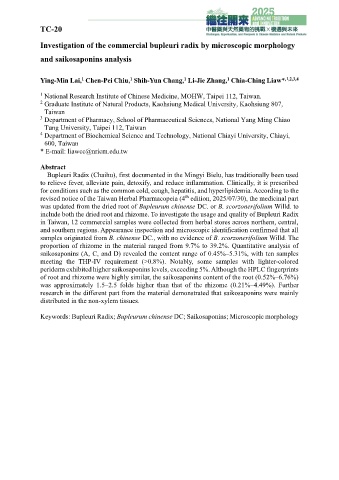Page 335 - 2025中醫藥與天然藥物聯合學術研討會-中醫藥與天然藥物的挑戰X機遇與未來大會手冊
P. 335
TC-20
Investigation of the commercial bupleuri radix by microscopic morphology
and saikosaponins analysis
1
1
1
Ying-Min Lai, Chen-Pei Chiu, Shih-Yun Chang, Li-Jie Zhang, Chia-Ching Liaw* ,1,2,3,4
1
1 National Research Institute of Chinese Medicine, MOHW, Taipei 112, Taiwan.
2 Graduate Institute of Natural Products, Kaohsiung Medical University, Kaohsiung 807,
Taiwan
3 Department of Pharmacy, School of Pharmaceutical Sciences, National Yang Ming Chiao
Tung University, Taipei 112, Taiwan
4 Department of Biochemical Science and Technology, National Chiayi University, Chiayi,
600, Taiwan
* E-mail: liawcc@nricm.edu.tw
Abstract
Bupleuri Radix (Chaihu), first documented in the Mingyi Bielu, has traditionally been used
to relieve fever, alleviate pain, detoxify, and reduce inflammation. Clinically, it is prescribed
for conditions such as the common cold, cough, hepatitis, and hyperlipidemia. According to the
th
revised notice of the Taiwan Herbal Pharmacopeia (4 edition, 2025/07/30), the medicinal part
was updated from the dried root of Bupleurum chinense DC. or B. scorzonerifolium Willd. to
include both the dried root and rhizome. To investigate the usage and quality of Bupleuri Radix
in Taiwan, 12 commercial samples were collected from herbal stores across northern, central,
and southern regions. Appearance inspection and microscopic identification confirmed that all
samples originated from B. chinense DC., with no evidence of B. scorzonerifolium Willd. The
proportion of rhizome in the material ranged from 9.7% to 39.2%. Quantitative analysis of
saikosaponins (A, C, and D) revealed the content range of 0.45%–5.31%, with ten samples
meeting the THP-IV requirement (>0.8%). Notably, some samples with lighter-colored
periderm exhibited higher saikosaponins levels, exceeding 5%. Although the HPLC fingerprints
of root and rhizome were highly similar, the saikosaponins content of the root (0.52%–6.76%)
was approximately 1.5–2.5 folds higher than that of the rhizome (0.21%–4.49%). Further
research in the different part from the material demonstrated that saikosaponins were mainly
distributed in the non-xylem tissues.
Keywords: Bupleuri Radix; Bupleurum chinense DC; Saikosaponins; Microscopic morphology

